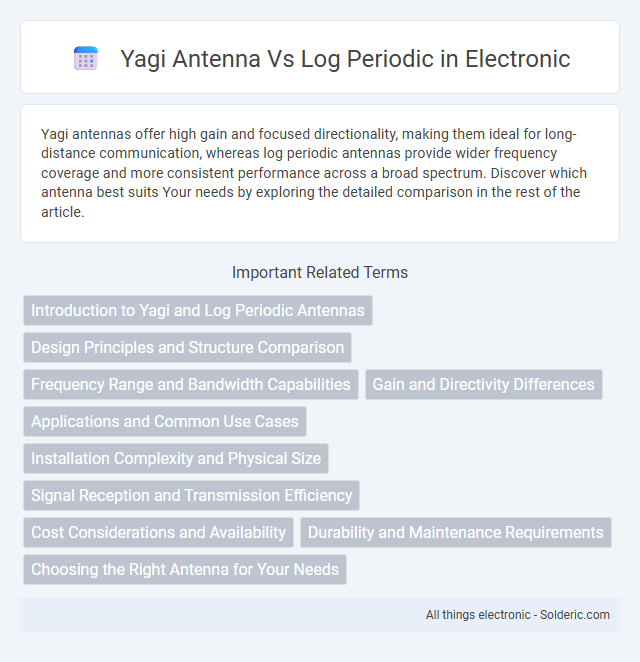Yagi antennas offer high gain and focused directionality, making them ideal for long-distance communication, whereas log periodic antennas provide wider frequency coverage and more consistent performance across a broad spectrum. Discover which antenna best suits Your needs by exploring the detailed comparison in the rest of the article.
Comparison Table
| Feature | Yagi Antenna | Log Periodic Antenna |
|---|---|---|
| Design | Single driven element with multiple parasitic elements | Multiple driven elements of varying lengths |
| Frequency Range | Narrowband, optimized for specific frequency | Wideband, covering broad frequency range |
| Gain | High gain at specific frequency | Moderate gain consistent across frequencies |
| Bandwidth | Limited bandwidth | Wide bandwidth |
| Front-to-Back Ratio | High, good signal rejection behind antenna | Lower compared to Yagi |
| Size and Weight | Smaller and lighter | Larger and heavier due to multiple elements |
| Typical Use | TV reception, point-to-point communication | Wideband scanning, frequency-agile applications |
| Impedance Matching | Fixed impedance, easier to match | Variable impedance, more complex matching |
Introduction to Yagi and Log Periodic Antennas
Yagi antennas feature a fixed design with a driven element, reflector, and multiple directors, providing high gain and directivity ideal for point-to-point communication. Log periodic antennas consist of a series of elements with gradually varying lengths and spacing, offering wide bandwidth and consistent performance across multiple frequencies. Your choice depends on whether you need focused signal strength or broad frequency coverage for optimal reception.
Design Principles and Structure Comparison
Yagi antennas feature a single driven element with multiple parasitic elements aligned linearly to enhance gain and directivity, typically optimized for narrow frequency bands. Log periodic antennas consist of a series of elements increasing in length and spacing logarithmically, enabling broad frequency coverage with moderate gain. Your choice depends on whether you need focused signal strength (Yagi) or wideband frequency performance (log periodic).
Frequency Range and Bandwidth Capabilities
Yagi antennas typically offer narrow bandwidth and operate efficiently within a limited frequency range, making them ideal for targeted frequency applications. In contrast, log periodic antennas provide broad frequency coverage with consistent performance across a wide bandwidth, suitable for multi-frequency use. The log periodic's ability to maintain relatively uniform gain over a wide range contrasts with the Yagi's optimized gain at specific frequencies.
Gain and Directivity Differences
Yagi antennas typically provide higher gain and greater directivity due to their fixed element design, making them ideal for focused, long-distance communication. Log periodic antennas offer a wider frequency range with moderate gain and consistent directivity across bands, enhancing versatility in varied applications. Your choice should depend on whether you prioritize maximum gain for specific frequencies or broad frequency coverage with stable performance.
Applications and Common Use Cases
Yagi antennas excel in point-to-point communication such as amateur radio, television reception, and radar systems due to their high gain and narrow beamwidth. Log periodic antennas provide wideband frequency coverage, making them ideal for applications like electromagnetic interference testing, spectrum monitoring, and broadband communication. Both antenna types are widely used in wireless telecommunications and signal direction finding but cater to different needs based on frequency range and gain requirements.
Installation Complexity and Physical Size
Yagi antennas generally feature simpler installation due to their fixed design with fewer elements, making them more compact and easier to mount on rooftops or poles. In contrast, log periodic antennas have a more complex structure with numerous elements of varying lengths, resulting in a bulkier physical size that demands careful alignment and sturdier mounting solutions. Your choice depends on the available installation space and the ease with which you want to set up your antenna system.
Signal Reception and Transmission Efficiency
Yagi antennas generally offer higher gain and better directivity, resulting in stronger signal reception and more efficient transmission in specific directions, making them ideal for fixed point-to-point communication. Log periodic antennas provide a wider frequency range with moderate gain, ensuring reliable signal reception and transmission across multiple bands for versatile applications. Your choice depends on the need for focused amplification with Yagi or broader frequency coverage with log periodic antennas.
Cost Considerations and Availability
Yagi antennas generally offer a lower cost and greater availability due to their simpler design and widespread use in amateur radio and television reception. Log periodic antennas are typically more expensive because of their complex construction and precision requirements, which makes them less common in retail markets. For budget-conscious buyers seeking easy procurement, Yagi antennas present a more accessible option compared to the specialized nature of log periodic antennas.
Durability and Maintenance Requirements
Yagi antennas generally offer higher durability due to their simpler design and fewer elements, making them more resistant to weather-related damage and easier to maintain. Log periodic antennas feature multiple closely spaced elements, which can increase maintenance complexity and susceptibility to wear over time. Your choice should consider that Yagi antennas typically require less frequent upkeep, ensuring more reliable long-term performance in harsh environments.
Choosing the Right Antenna for Your Needs
Yagi antennas offer high gain and narrow beamwidth, making them ideal for long-distance, point-to-point communication where signal directionality is crucial. Log periodic antennas provide wide frequency coverage and moderate gain, suitable for applications requiring broadband performance and frequency agility. Selecting the right antenna depends on balancing gain, bandwidth, and intended use; Yagi suits focused, high-gain tasks, while log periodic excels in versatile, wideband scenarios.
yagi antenna vs log periodic Infographic

 solderic.com
solderic.com